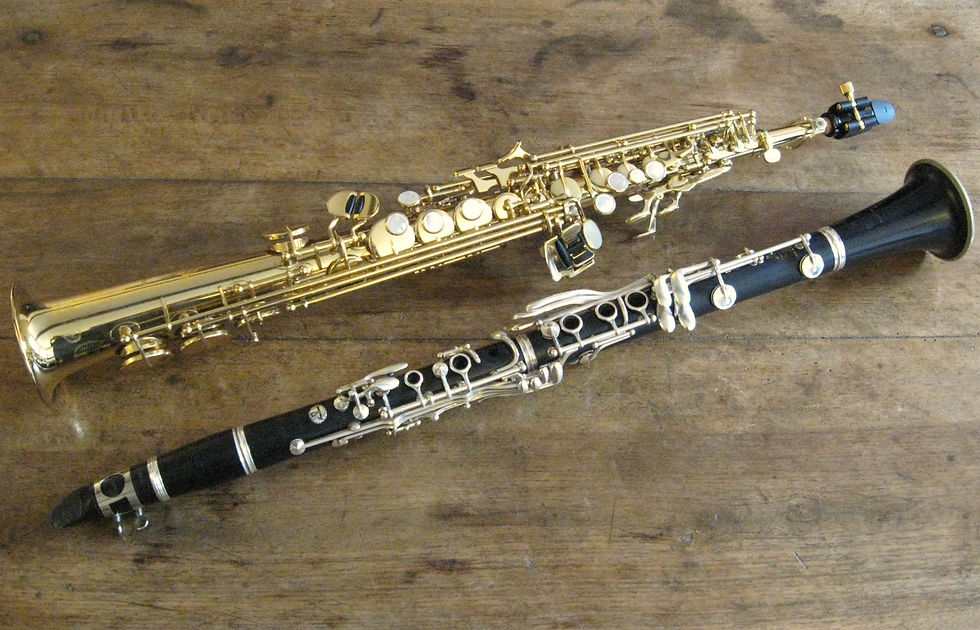Clarinet And Saxophone - Luck Of The Reed Box
- Edward Brown

- Dec 18, 2020
- 3 min read
Updated: Feb 8, 2024
When you open a new box of reeds, you'll find one you favour and another you think is awful, despite being the exact same strength, out of the same box. Why is that? Let's find out.

REEDS, CLARINET REEDS, SAXOPHONE REEDS
A disclaimer here first of all: my observations only cover Vandoren and Rico, since those are the makes I use most often. I'm also only referring to clarinet and saxophone reeds made from cane, not plastic or other synthetics.
There are many different makers of reeds for woodwind instruments out there. Big names include Vandoren, Rico, D'Addario, Alexander, etc., each having their own different types, like Vandoren's V12 or Rico's La Voz. We all have our favourites but you'll remember in a previous blog, if you had not done so already, I encouraged experimentation with these different makes and types of reeds. They all change the tone quality of your musical instrument in both subtle and distinct ways and you may not have found your favourite yet, even if you think you have.
Over the years, like myself, you'll have discovered, however, that there is a disparity between the reeds in a box. Sometimes it's subtle and only with a couple out of the ten we get. Other times, it's a good half of the box that play well and the other half are a write-off. Why is this though?
A DODGY CUT OF REED
Reeds, as we know, come in different strengths, which are cut to the specific dimensions but since cane is a natural material, sometimes the grain within the cane is inconsistent in strength. You can usually see this by putting your reed up to a light source and seeing where the darker and lighter areas are towards the tip of the reed.

Within this photo are three 'regular' (dark blue packet) Vandoren alto saxophone 2.5 reeds, fresh out of their wrappers, from the same box I opened up just before writing this blog. While the image quality isn't the best, you should be able to notice the difference in the dark and light areas of the tips.
Personally, I would say the middle reed is the better of the three; the dark vertical lines of grain are fairly evenly spread, there isn't much light area in comparison to the outer two reeds, and the light-to-dark horizontal change fades fairly evenly. This means the reed will feel more stable in tone quality, able to maintain both high and low notes more easily, and won't take as long to deteriorate due to the evenness of the cut, leaving no weak areas.
On the outer two reeds, we can see there is a darker area towards the middle of the reed, which then highlights the fact that the outer edges of each reed are weaker in thickness. This could cause the reed to squeak more, make the high notes seem weaker, or just cause the reed to deteriorate at a quicker rate. The main issue is that these two reeds won't 'feel' like 2.5 reeds, more like 2's.
BE PICKY WITH YOUR REEDS
Your experience might be different to mine. You might not notice much difference between your reeds. Maybe you prefer the weaker reeds and dislike finding a 'tough' reed amongst your box of ten. It's all personal preference but, ultimately, by being more vigilant with your reeds, you'll soon find out what your favourite reed looks like, able to quickly discard the ones you don't like, or sell them on to someone else who might favour them more.
Yes, reeds are expensive but you just have to resign to the fact that sometimes they won't all be perfect and it's the luck of the draw. If you're that bothered, you can always go with plastic reeds or try to find a make that isn't so inconsistent.
Let me know your experiences with reed disparity. Which reeds are more reliable for you?
P.S. If you are looking for clarinet lessons or a saxophone teacher near you, I offer face-to-face music lessons in Wells, UK and online music lessons to anyone worldwide. Feel free to get in touch!



Comments